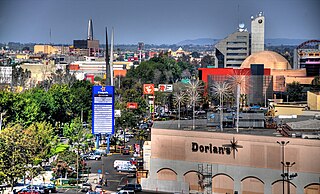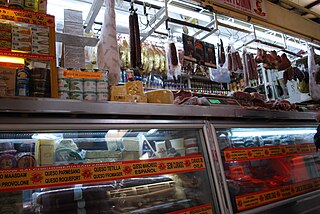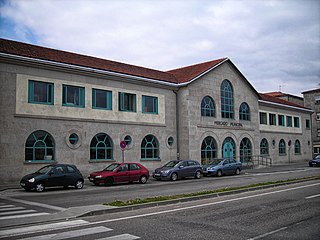
Piedras Negras is a city and seat of the surrounding municipality of the same name in the Mexican state of Coahuila. It stands at the northeastern edge of Coahuila on the Mexico–United States border, across the Rio Grande from Eagle Pass in the U.S. state of Texas. In the 2015 census the city had a population of 163,595 inhabitants, while the metropolitan area had a population of 245,155 inhabitants. The Piedras Negras and the Eagle Pass areas are connected by the Eagle Pass–Piedras Negras International Bridge, Camino Real International Bridge, and the Union Pacific International Railroad Bridge.

The San Antonio River Walk is a city park and special-case pedestrian street in San Antonio, Texas, one level down from the automobile street. The River Walk winds and loops under bridges as two parallel sidewalks lined with restaurants and shops, connecting the major tourist draws such as the Shops at Rivercenter, the Arneson River Theatre, Marriage Island, La Villita, HemisFair Park, the Tower Life Building, the San Antonio Museum of Art, the Pearl, and the city's five Spanish colonial missions, which have been named a World Heritage Site, which includes the Alamo. During the annual springtime Fiesta San Antonio, the River Parade features flowery floats that float down the river.

El Cerrito Plaza is a shopping center in El Cerrito, California, a suburb in the San Francisco Bay Area.

A tianguis is an open-air market or bazaar that is traditionally held on certain market days in a town or city neighborhood in Mexico and Central America. This bazaar tradition has its roots well into the pre-Hispanic period and continues in many cases essentially unchanged into the present day. The word tianguis comes from tiyānquiztli or tianquiztli in Classical Nahuatl, the language of the Aztec Empire. In rural areas, many traditional types of merchandise are still sold, such as agriculture supplies and products as well as modern, mass-produced goods. In the cities, mass-produced goods are mostly sold, but the organization of tianguis events is mostly the same. There are also specialty tianguis events for holidays such as Christmas as well as for particular types of items such as cars or art.

A marketplace or market place is a location where people regularly gather for the purchase and sale of provisions, livestock, and other goods. In different parts of the world, a marketplace may be described as a souk, bazaar, a fixed mercado (Spanish), or itinerant tianguis (Mexico), or palengke (Philippines). Some markets operate daily and are said to be permanent markets while others are held once a week or on less frequent specified days such as festival days and are said to be periodic markets. The form that a market adopts depends on its locality's population, culture, ambient and geographic conditions. The term market covers many types of trading, as market squares, market halls and food halls, and their different varieties. Thus marketplaces can be both outdoors and indoors, and in the modern world, online marketplaces.

Zona Río is an official zone, and the main modern business district, of the city of Tijuana, Mexico.

Downtown San Antonio is the central business district of San Antonio, Texas and the urban core of Greater San Antonio, a metropolitan area with nearly 2.5 million people.

La Latina is a historic neighborhood in the Centro district of downtown Madrid, Spain. La Latina occupies the place of the oldest area in Madrid, the Islamic citadel inside the city walls, with narrow streets and large squares. It is administratively locked almost entirely within the district of Palacio in Centro. It was named after the old hospital, founded in 1499 by Beatriz Galindo "La Latina". It occupies a large part of what is known as El Madrid de los Austrias, and although its boundaries are subjective, it could be argued that it was essentially the vicinity of the carrera de San Francisco street - that continues from the Plaza de la Cebada up to the San Francisco el Grande Basilica. These limits are: to the north, Segovia street - a deep ravine formerly occupied by the San Pedro Stream which empties into the Manzanares River, to the south there is la Ronda and Puerta de Toledo, on the east there is Toledo street - bordering Rastro and the district of Lavapiés - and to the west, Bailen street.

La Lagunilla Market is a traditional public market in Mexico City, located about ten blocks north of the city's main plaza, in a neighborhood called La Lagunilla. The market is one of the largest in the city and consists of three sections: one for clothing, one for furniture and one for foodstuffs, mostly selling to lower income customers. The market is surrounded by small stores and street vendors, many specializing in furniture and dresses and other needs for formal occasions. On Sundays, the number of street vendors grows significantly, a weekly “tianguis” market called a baratillo which traditionally sells used items. One section of this baratillo has developed into a market for antiques, which has attracted higher income customers and even famous ones such as Carlos Monsiváis.

Traditional fixed markets in Mexico are multiple-vendor markets permanently housed in a fixed location. They go by a variety of names such as "mercados públicos", "mercados municipales" or even more often simply "mercados" (markets). These markets are distinct from others in that they are almost always housed in buildings owned and operated by the local government, with numerous stands inside rented by individual merchants, who usually sell, produce and other basic food staples. This market developed in Mexico as a way to regulate pre Hispanic markets called tianguis. These tianguis markets remain in Mexico, with the most traditional held on certain days, put up and taken down the same day, much the way it was done in Mesoamerica.

The Michoacán Market is a “mercado público" or traditional retail food market located in Condesa, one of the more prestigious districts of Mexico City. It is located between Avenida Michoacán, Avenida Vicente Suárez, and Avenida Tamaulipas streets, where three intersect.

Lowe's Market is an American regional supermarket chain, primarily in West Texas and South Texas and throughout New Mexico. The company also operates stores in Colorado, Arizona and Kansas. The company's home office is in Littlefield, Texas.

A food hall is a large standalone location or department store section where food and drinks are sold.

Ponce Servicos, formerly Plaza del Mercado Juan Bigas, is a brutalist municipal building located Ponce, Puerto Rico. It is the largest building in the municipality in terms of footprint area and the only one that occupies an entire city block. The structure was built in 1981 as a way to provide a modern, air-conditioned, structure for the merchants and shoppers of the historic but aging Plaza de Mercado Isabel II building, while the latter underwent restoration. On its opening day it was named Plaza del Mercado Juan Bigas, in honor of Juan Bigas Moulins, the Ponce businessman by that name.

The San Juan Market is a traditional Mexican market in the historic center of Mexico City that has become the city’s only such market specializing in gourmet and exotic foods. It is known for its selection of exotic meats, including venison, crocodile, wild boar and even lion meat, as well as a wide selection of products from Europe and the Americas. Unlike other such markets in Mexico City, it caters to chefs, restaurateurs and foodies, many of whom are foreigners and have long-standing relationships with particular vendors.

Malasaña is an area in the centre of Madrid, Spain. It does not correspond to any administrative division, but it is often conflated with Universidad, the wider administrative neighborhood on which Malasaña is located. The webpage providing touristic information published the Madrid City Council set as limits the streets of San Bernardo, the Gran Vía, Fuencarral and Carranza. Malasaña is associated with a creative and counter-cultural scene.
CenterMark, formerly known as May Centers, was a mall development company owned by a consortium of Westfield Holdings Ltd., General Growth Properties, and Whitehall Street Real Estate L.P. III. And it was formerly owned by The May Department Stores Company until 1992, and Prudential Insurance until 1993.

The Central Market of Pontevedra is a covered market located in Pontevedra, Spain. It is located at the north-eastern edge of the historic centre, close to the Burgo Bridge. It overlooks the banks of the Lérez river and was inaugurated in 1948.

La Placita is a historic district and neighborhood of Santurce, San Juan, Puerto Rico, located in the former area of Santurce's old market square in Campo Alegre. La Placita today is a popular dining and nightlife destination in San Juan, while still functioning as a produce and food market during the day.

El Mercado Latino is a grocery and specialty store at Seattle's Pike Place Market, in the U.S. state of Washington.



















